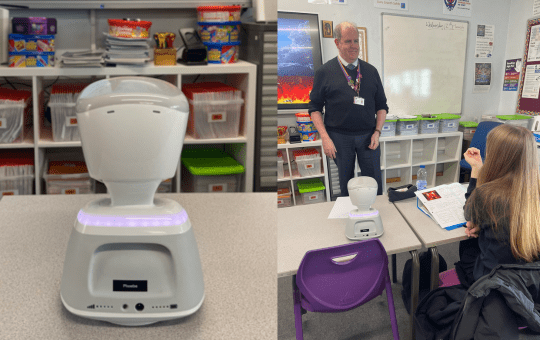About Phoebe
Phoebe is an articulate and creative Year 10 student. Her favourite subjects are music, history and biology. She also enjoys football, drumming, skateboarding, swimming, and online gaming. She has a good network of friends who are very important to her.
Due to a condition which causes her chronic pain Phoebe has been unable to attend school this year. She continues to engage with online tuition with support from her family, school staff and other health professionals to achieve her education goals.
Phoebe is determined to sit her GCSE exams and is optimistic about her future. She greatly values her friends and is determined to stay connected them.
Environment
CENMAC has worked with Phoebe’s family to make her home environment as suitable as possible to enable her to access her studies comfortably.
Phoebe’s physical environment has been thoughtfully adapted to meet her needs. At home, modifications include ramps, a downstairs wet room, and a bedroom downstairs, ensuring she can navigate her surroundings safely and independently. Phoebe relies on her wheelchair and assistive technology to facilitate learning.
Her support network extends beyond her family and includes her school, which provides online teaching and regular engagement to help her stay connected. Phoebe’s friends often visit her at home, ensuring she maintains some social interaction despite her isolation from the traditional school environment.

Phoebe
Phoebe has written a blog about how the AV1 robot has helped her. She now looks forward to online lessons instead of dreading them.
Technology and input
Phoebe’s journey highlights the transformative role of assistive technology in bridging the gap between her physical limitations and academic curriculum. Phoebe was using a laptop to complete schoolwork, along with textbooks, worksheets and some online lessons. This was not really working for her and she felt very isolated. Phoebe needed a more comprehensive solution so CENMAC provided an AV1 robot paired with an iPad.
What is an AV1 robot?
The AV1 robot (https://www.noisolation.com/uk) is a virtual presence device designed to support students who can’t attend school in person. The AV1 sits in their place in the classroom and acts as their eyes, ears, and voice in the classroom. The student connects to the robot through an app on their tablet, which allows them to see and hear everything happening in class. They can also control the robot’s movements, turn its head, and even raise their hand to participate in discussions. This way, the child can stay connected with their classmates and continue their education from home.

AV1 robot sitting in Phoebe’s place in the classroom
Training the support team
During Phoebe’s assessment, her school team received some hands-on training on how to use the robot in school. Following the school training session, the equipment was taken to Phoebe’s home and she was shown how to use the AV1 robot and the iPad to control it. It was really important that Phoebe’s family were involved in the training as they will be supporting her when she is using the devices. The iPad stayed with Phoebe at home and the robot went back to school. The AV1 robot sits in class and allows Phoebe to virtually attend classes, interact with peers, and remain connected to the school community.
Main aim of the technology and support
The primary goal of introducing the AV1robot is to ensure that Phoebe can access her curriculum, even when she is unable to attend classes in person. The AVI robot also helps to reduce Phoebe’s feelings of isolation by enabling greater social interaction with her friends and participation in school life. The AV1 robot empowers Phoebe with tools that enhance her independence and confidence in managing her access to education.
Impact and Successes
The implementation of assistive technology is showing promising outcomes. Phoebe has demonstrated confidence in using the technology, making access to her learning resources easier.
During the first week after she received the technology, Phoebe was invited to a tea party in the Deputy Head’s office via the robot, with a small group of her friends. The DH said: “It worked beautifully. Phoebe was able to interact with me in my office. She was able to communicate very easily to a group of her friends and managed to navigate all the buttons on the iPad.”
The robot has helped to boost Phoebe’s morale. The adaptations and unwavering support from her school, family, and professionals make her feel valued, heard and understood, motivating her to strive toward her aspirations.
Key strengths of the technology
The power of inclusion: Physical absence doesn’t have to equal exclusion. Not only can Phoebe attend her lessons, but she can also catch up with her friends, fostering a sense of belonging even when her physical attendance isn’t possible.
The importance of teamwork: A collaborative effort by family members, school staff, Phoebe’s classmates and CENMAC enabled a holistic solution that addresses not only Phoebe’s academic needs but also her emotional and social needs.
Adaptability is key: Phoebe’s needs are unique, and the flexibility to adapt technology and teaching methods is critical to the success of the technology.
Case Study Author: Maureen De Longhi, CENMAC Advisory Teacher



